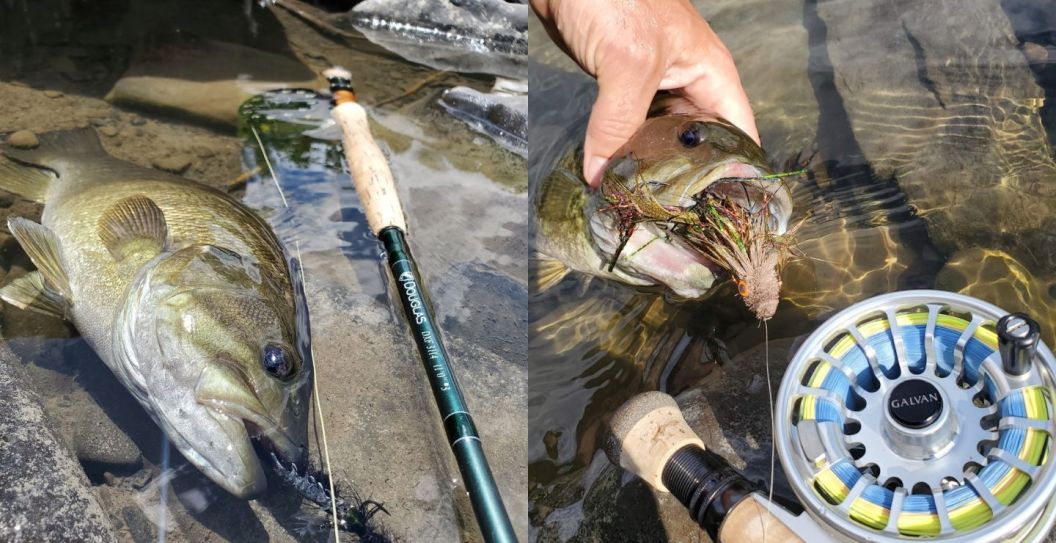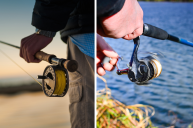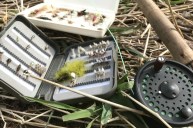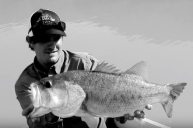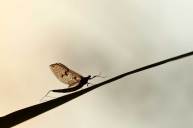At first glance, pairing fly fishing and bass fishing might seem incompatible. Fly fishing is portrayed as all tiny dry flies and subtle presentation; bass fishing is about bobbers, crank baits, and winning tournaments. In fact, fly fishing for bass is challenging, exhilarating, and frankly one of the best species to fly fish for across the entire country.
It's true that fly fishing for trout and bass can be very different experiences. Trout are gentlemanly fish. Bass are frat boys. Trout have high standards for discernment; they must be presented with the right fly, using the right method, at the right location. Bass will take a swipe at almost anything flashy enough to catch their attention, and when they do hit, it's often like a bomb going off on your fly.
Don't be fooled: though you can totally catch a ton of bass as a beginner, bass fishing with fly equipment presents a unique challenge. Fly fishing for bass involves different techniques and different flies than fly fishing for trout. Targeting bass can bring anglers to new waters they may not have fished before, since bass fishing is often associated with lakes, ponds, and other warmer-water locations, including large rivers and even deltas. And when you do hook a bass, get ready for a fight like you might not have experienced on a fly rod.
If you are new to fly fishing or just have always fly fished for trout, bass should be on your spring and summer bucket list this year. We promise the first bass you hook into will be a game changer. Let's take a deep dive into the intricacies, gear, presentations, and fly fishing techniques for bass—you'll be catching them in no time.
Bass Species to Target While Fly Fishing
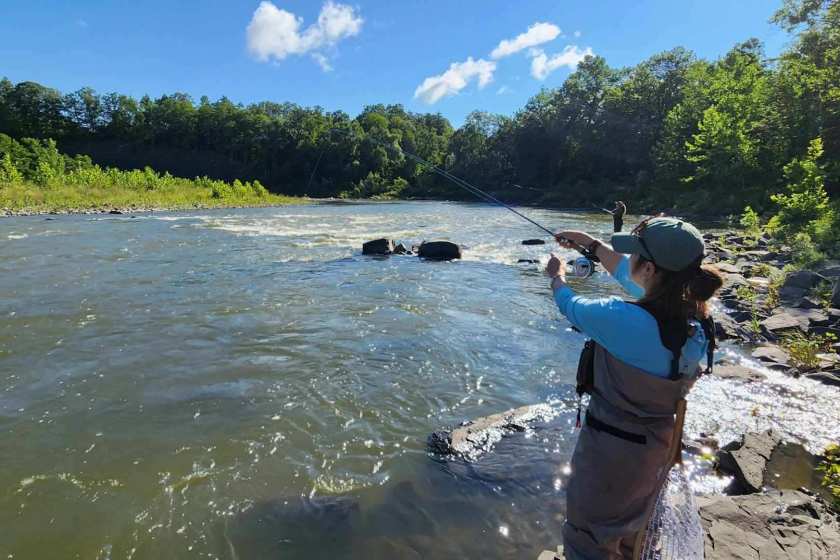
Megan Plete Postol
There are three main types of bass that can be targeting while fly fishing: smallmouth bass, largemouth bass, and stripers.
Smallmouth bass are a native North American bass species that are a shiny bronze to brown or even greenish brown color with a mouth that opens to approximately the middle of their eye. Their sides are marked by brown vertical bands. Smallmouth bass often cohabitate the same types of water that trout do, such as cold, spring-fed streams. Compared to its sister species, the largemouth bass, smallmouths tend to stick to cooler, often deeper, water.
The aptly named largemouth bass have a jaw that extends further back, beyond the eye. Coloration is slightly more greenish with a defined black lateral line. Largemouths tend to prefer warmer, murkier, more shallow water than their smallmouth counterparts. They can often be found hugging the shorelines of small ponds or in shallow, lily pad lined bays of larger lakes.
Stripers, often called striped bass, are found primarily along the Atlantic coast of North America and in connecting waterways such as the Hudson River. They are anadromous, thriving in fresh, brackish, and saltwater, and get very large, often up to forty pounds and above. Stripers can be identified by their dark colors and horizontal stripes, spanning along their body from their gill plate to the beginning of their tail, body paired with a shiny white underbelly. Stripers, especially larger ones, require heavier gear than largemouth and smallmouth bass; consult with a local fly shop to make sure you're ready.
Fly Fishing Gear For Bass
Fly fishing for bass does not have to be complicated. A 9-foot 5-weight rod and reel will work plenty of the time. But bass-specific gear helps. For throwing heavy flies and streamers (we'll get into that in a bit), the perfect bass rod is usually a 9-foot, fast action, 6- to 8-weight rod, such as the Orvis Helios 9-foot rod in the 7 weight. Another really good choice is the JP Ross Coherence 9-foot, 6-8 weight rod. It's perfect for throwing big streamers at fish such as bass.
For heftier fish like stripers, you'll need beefier equipment, such as the Orvis Helios D 8-foot, 5-inch 10 weight fly rod, which delivers strength and accuracy. It is both durable and precise. Pair whichever rod you choose with a fly reel equipped with an adjustable drag. If fishing for stripers, make sure it's a saltwater capable reel with a sealed drag to fight off corrosion.
For targeting bass while fly fishing, rig the rod with a decent fly line, such as Scientific Anglers Amplitude Smooth Titan Long Two Size Heavy Line. This line is ideal for throwing big flies for hungry fish; plus, it turns over and shoots big, wind resistant flies well. Another solid option is Cortland Line Company's Bass Intermediate Specialty Series. Made specifically for targeting bass with a fly, this line features a short, aggressive taper with a with a 26-foot intermediate tip, which allows your fly to get down in current and effectively fish submerged structure.
Leader and tippets for bass are another big change from trout fishing. A 7.5- or 9-foot leader in 2x to 4x works just fine for most bass situations. Tippet should be in the same 2-4x range; for larger fish I sometimes tie my fly directly into my leader.
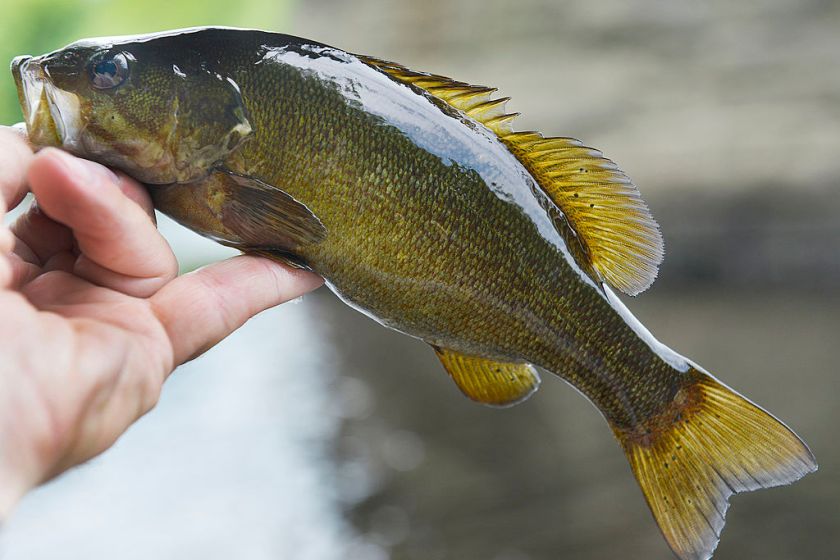
Getty, Portland Press Herald
Best Flies and Techniques for Bass Fishing
Here's the good news: Bass are eating machines. That's one reason they're so fun to fish for. If you can get your fly in front of one, there's a decent chance you'll hook up.
There are basically three categories of flies used to target most bass: poppers, nymphs, and streamers. Bass eat tadpoles, crayfish, frogs, and other baitfish, so anything that remotely resembles those can work. Bass aren't picky, but tend to like large, flashy presentations.
One tried and true streamer fly option is a wooly bugger. The wooly bugger is a versatile option, especially great for beginners targeting bass with a fly. Cast any streamer parallel to the bank and strip in firm, focused motions. Just like with any type of fly fishing, getting your fly to the right depth is key. An unweighted wooly bugger cast on a floating line will behave like an injured baitfish stranded near the surface; fish a wooly bugger with a beadhead or on weighted line to get it down deeper into the water column, where hungry bass are suspended, waiting for lunch.
Another good option for bass fishing with fly gear is to throw a blockhead popper. Poppers make a surface motion that resembles prey in distress that gets bass attention. Cast past where bass might be hiding and strip past with short but deliberate motions. Remember to let the fly sit still or simply twitch it for a moment, and be ready for a vicious strike. Always use a floating line while fly fishing with poppers; they are designed for topwater action.
Some anglers swear by topwater deer hair poppers for bass, especially around the edges of cover sources, such as weed beds or downed trees. Like other poppers, throw them out, pause, and give them a tug. Let them make a commotion to attract the bass. What sets a deer hair popper apart is the "softer" effect it creates as it moves through the water.
In a river, dead-drifting a large nymph fly like a black stonefly nymph can produce a bass bite. Even better is a slow-retrieve and twitch technique with a large nymph: In tiny increments, strip in your fly with your left hand. Some anglers also wrap the fly line around their fingers to create this slow-retrieve "twitch." The idea is to mimic the tiny movements of these insects as they "swim" through the water column. Whether you're swinging a fly through a current or just slow-retrieving in still water, nymphing techniques can work well on bass that have seen a number of streamers and won't be fooled.
Conditions and Cover for Bass
Ultimately, the technique you try should be tailored to the conditions and location of that particular day. In colder waters, bass might be a bit more sluggish, and therefore, slower on the bite. When facing this scenario, try a slow-steady retrieve with intermittent pauses. This gives the bass a chance to notice the fly and hoover it up with its gigantic mouth. In warmer waters, a quicker, less leisurely retrieve might be the best way to trigger an aggressive predator response.
Bass like to linger in areas that have some type of cover, such as weed beds, lily pads, downed trees, and submerged boulders. Cast towards the cover source and work back towards yourself. Think about the lake or pond's natural structure. If there is a drop off or some type of structure on the bottom, that will be another place to target bass.
While fly fishing for bass in ponds or even lakes, notice where the water moves, such as at inlets and culvert openings. That movement oxygenizes the water and dumps food into the water. Bass often hangout at the edges of these moving water areas, especially after rainfall. Cast around these moving pools to target hungry bass.
Get Ready for a Big Fight While Fly Fishing For Bass
Success while fly fishing for bass means a heckuva tug. This is a huge difference in fly fishing for bass versus fly fishing for trout: what happens when the fish bites, and how you need to respond.
Bass often hit hard. But resist the urge to yank the rod back high and hard, like you would do with a spinning rod. Instead, setting the hook on a bass is somewhere in between the gentle "lift" of a trout set and the huge yank of a spin fisherman. Bass eat by vacuuming up their food, and will quickly turn away. This means the fly is likely solidly in their mouth. Set the hook after a take by lifting and taking up slack with your left hand. Line management while fighting a bass is key: they fight like tanks, and often jump (especially smallmouth bass). Control the fish by keeping pressure on with your rod tip; the basic tip for a fish that jumps is to give it slack by "bowing" slightly (in most cases, just drop the rod tip or let out a little slack if possible).
Though bass are hardy fish, you should still take care while landing them. Grab a pic, enjoy their beauty, and, if you're not eating it as a delicious bass dinner, put it back for the next angler to enjoy.
READ MORE: To Trick a Trout, Swing a Wet Fly
